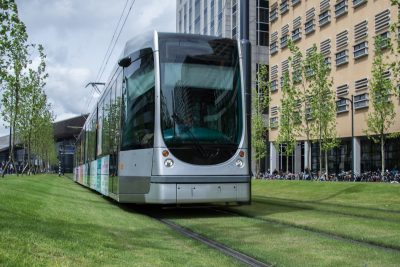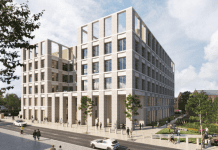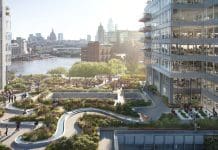Paul Nathanail, managing director of specialist environmental consultancy Land Quality Management Ltd discusses how any new residential development needs to take a long, and creative, view on transport infrastructure provision.
Virtually all of us will have enjoyed congestion-free roads during the recent school holidays and wished the commute to work was so hassle free – and quick – every day. Few of us, outside London, will commute by bus. Many of us will also have suffered the frustration of being without a car; it is being serviced, a newly qualified offspring has borrowed it, the morning commute is hampered by a puncture.
Now imagine not being able to drive at all – for a while or permanently. How will that commute or trip to the shops, doctor or nearby family and friends take place? Walking or cycling may suit some of us, but is it possible for all of those journeys? If only there was a convenient public transport solution…
 Large housing developments on the edge of conurbations are one way of delivering on the ambitious housing targets the Government has set the country. Such new estates can not always encompass local services such as convenience shops forcing new residents to travel to meet even their most basic needs.
Large housing developments on the edge of conurbations are one way of delivering on the ambitious housing targets the Government has set the country. Such new estates can not always encompass local services such as convenience shops forcing new residents to travel to meet even their most basic needs.
At the November 2018 UK Bus Awards[1] ceremony, Stagecoach won the gold award in the Making Buses a Better Choice category for its Bus Services in New Residential Developments[2] guidance. High quality bus services require roads, designed as Primary Streets, along which relatively large vehicles can make safe and relatively efficient progress, multiple times per hour, in two directions thereby prioritising “movement” and “circulation” through design.
In December, I took part in the public examination of the draft Local Plan Part 2 of Broxtowe Borough Council. The topic of encouraging bus services to several major new housing developments being proposed on the edge of the Nottingham’s main built up area, in land currently within the green belt and forming an important part of local green infrastructure, was discussed in some detail.
It was agreed that although providing access adjacent to these developments would at first glance be simpler but less convenient for residents and potentially disruptive to other road traffic.
Ideally, what was needed was a bus service through the development that would generate enough revenue through ticket sales, s106 support and council or other subsidy, but without adversely impacting the viability of the overall development scheme. I suggested the Stagecoach guide as a source of solutions as the detailed design of the new estate is worked through.
Creative design, based on sound understanding of the local built, natural and intended environments, can help deliver multiple-functionality public realm.
In one case, a strip of land through the middle of a proposed residential development was to be left unbuilt to form part of the sustainable drainage system. Maps showing the development site in context suggested that this strip could also serve as part of a wildlife corridor connecting urban parkland with the open countryside and… a “tank trap”[3] that involves the bus straddling a narrow pit, with a raised island at either end, which creates a physical barrier for most cars, is awkward for motorcycles but readily permits emergency access for fire appliances or other blue light vehicles.
Where there is a will – and a sound evidence base – there may well soon be a way!
[1] https://www.stagecoachbus.com/news/national/2018/november/uk-bus-award-winners
[2] https://www.stagecoach.com/~/media/Files/S/Stagecoach-Group/Attachments/pdf/bus-services-and-new-residential-developments.pdf (devised by Dr Nick Small, Stagecoach UK Bus Head of Strategic Development and the Built Environment)
[3] https://www3.northamptonshire.gov.uk/councilservices/northamptonshire-highways/transport-plans-and-policies/Documents/Revised%20Bus%20Strategy%20October%202017%20compressed_v2.pdf
This is a personal view and guest blog written for Argyll Environmental by Paul Nathanail, managing director of specialist environmental consultancy, Land Quality Management Ltd.
















